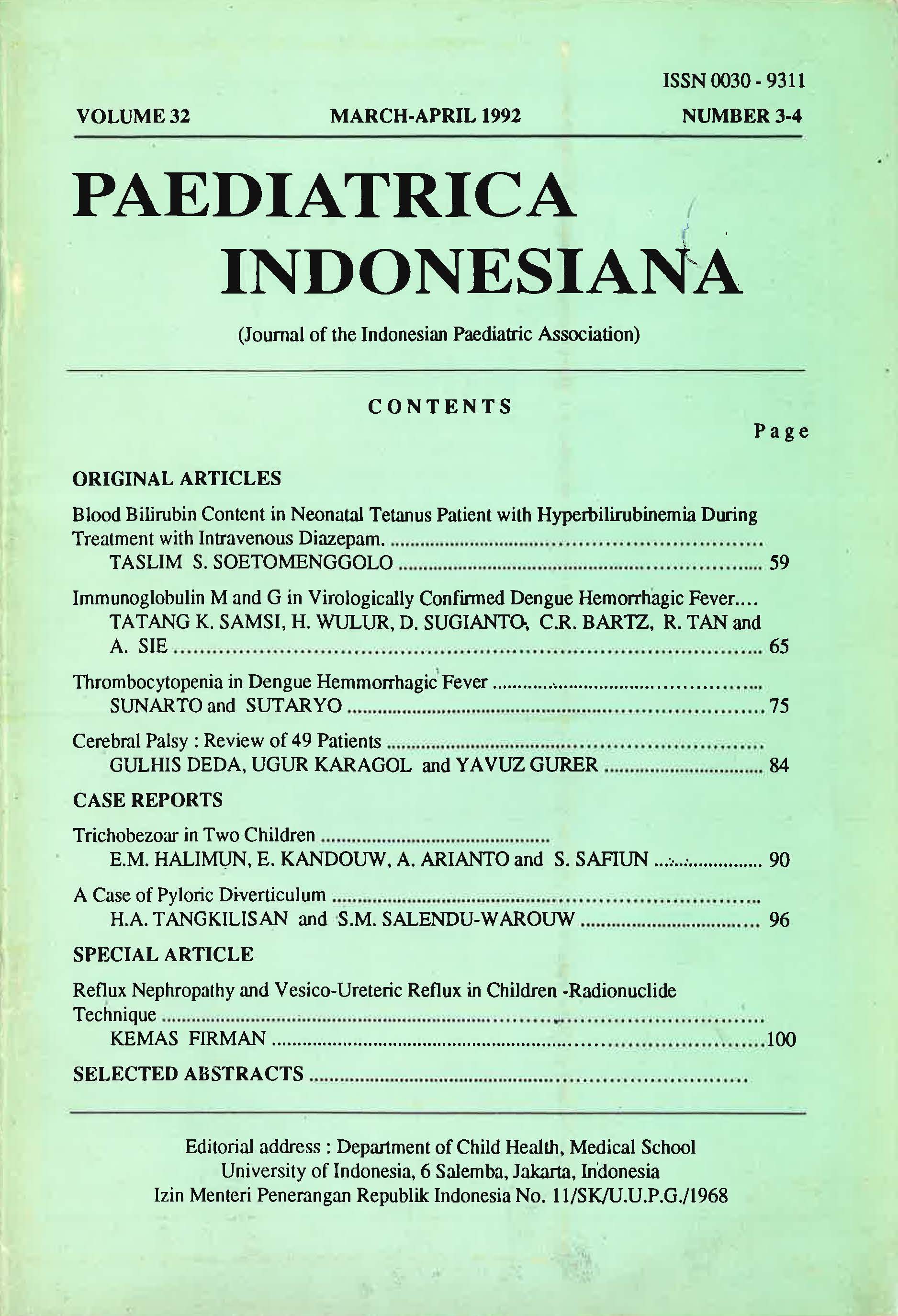Immunoglobulin M and G in Virologically Confirmed Dengue Hemorrhagic Fever
DOI:
https://doi.org/10.14238/pi32.3-4.1992.65-74Keywords:
immunoglobulin M; immunoglobulin G; dengue hemorrhagic fever; DHF; IgG; IgMAbstract
Starting from September 1987, a one year prospective study on lgM and lgG in dengue hemorrhagic fever, was carried out at the Department of Pediatrics, Sumber War as Hospital West Jakarta. This report describes the preliminary finding of the study from September 1987 through June 1988.
Virus isolation and serologic analysis (HI, lgG and lgM capture ELISA) for DHF were done by NAMRU 2 in Jakarta. The subjects were 151 virologically confirmed DHF patients consisting of 82 boys and 69 girls of 6 months - 15 years old.
Serum samples were collected: (I) on the day of admission; (II) on the day of discharge and (Ill) 2 weeks after the first samples. Serum samples I, II, and Ill were collected from respectively 151, 131 and 64 subjects on respectively 3.5 ± 1.7; 8.8 ± 2.7 and 16.8 ± 2.1 days of illness. Positive lgM titer from acute sera was observed in 20% of subjects. A positive correlation between HI -lgM and HI -lgG was also observed.
The percentage of positive lgM titers rose with the increase of HI titer, the percentage of positive lgG titer was lower than that of /gM but a sudden increase exceeding that of lgM was observed at the HI liter of 320 and more.
This study revealed that HI titer of640 and 1280 were indicators for the primary and secondary dengue infection respectively and lgM capture ELISA can be used as a reliable predictor for DHF even more in fatal cases where only single serum is available.
References
2. Gubler D.J.W. Suharyono, R. Tan, M. Abidin and A. Sie :Virmia in patients with naturally acquired dengue infection. Bull. WHO 59: 4, 1981.
3. LK. Kho. Wulur, A. Karsono and Suprapti Thaib : Dengue hemorrhagic fever in Jakarta, MKI, 19-12, 1989.
4. L Partana, J .S. Partana and S. Tharir. Hemmonbagic fever shock syndrome in Surabaya. Kobe J. Med. Sci. 16, 1970.
5. Lam S.K.,S. Devi and Pang T. Detection of spesific lgM in dengue infections. Sauth-east Asi6n J. Trop. Med. Pub. HI Lh. 18-4,1987.
6. Russell P.K., Udhamsakdi S. and Halstead S.B.: Antibodi response in dengue and dengue hemorrhagic faver. Jap. J. Med. Sci. Biol. 20:103, 1967.
7. Russell P.K., Intavivat A and Kanchanapilant S. : Antidengue Immunoglobulin and Bi globulin level in dengue shock syndrome.J.Imm. 102: 2, 1969.
8. Scott R.M., Nimmanitya S., Bancroft W.H. and Mansuwan P. Shock syndrome in primary dengue infections. Am. J. Trop. Med. Ryg. 12 : 4, 1974.
9. Sri Rezeki Harun, Paleologo dan M.S. Muluk. Titer serologi dasar HI virus dengue pada anak sekolah di
Jakarta, Vllth National Congress of Pediatrics, Jakarta, 1987.
10.World Health Organization. Dengue hemorrhagic Fever : Diagnosis, treatment and control. WHO, Geneva, 1986.
Downloads
Published
How to Cite
Issue
Section
License
Authors who publish with this journal agree to the following terms:
Authors retain copyright and grant the journal right of first publication with the work simultaneously licensed under a Creative Commons Attribution License that allows others to share the work with an acknowledgement of the work's authorship and initial publication in this journal.
Authors are able to enter into separate, additional contractual arrangements for the non-exclusive distribution of the journal's published version of the work (e.g., post it to an institutional repository or publish it in a book), with an acknowledgement of its initial publication in this journal.














